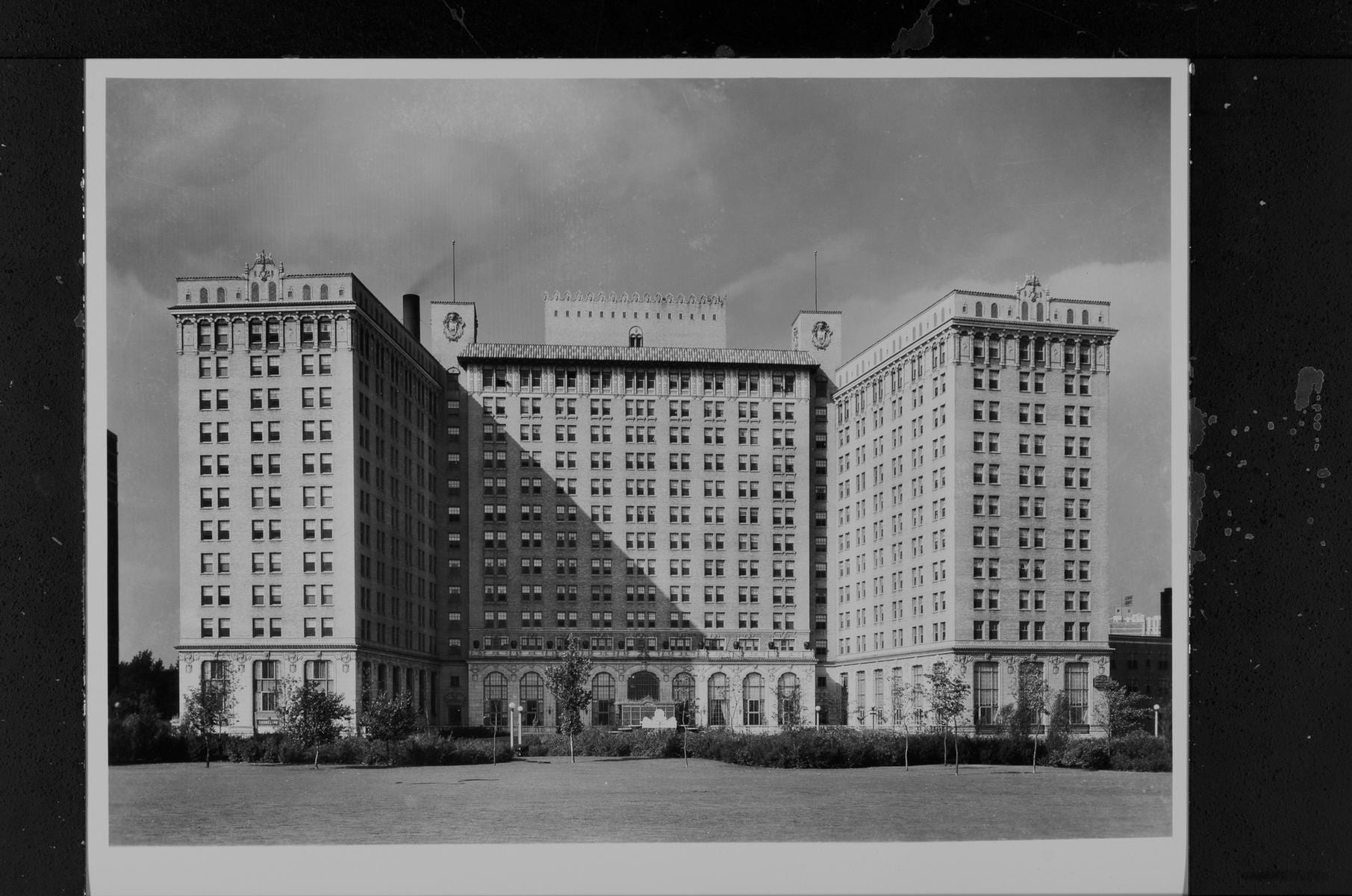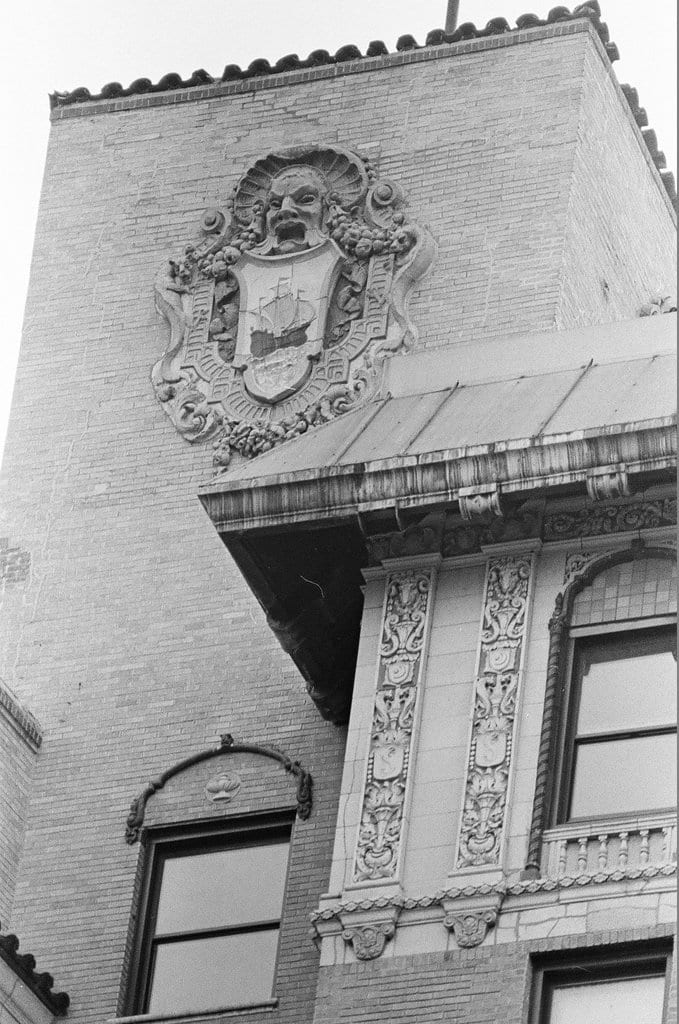During the summer of 1923, writer Edna Ferber—frustrated, silk-clad, and sweltering in the 96-degree Chicago heat—sat at her typewriter agonizing over a draft of her novel, So Big. Her locale was the Windermere, a neoclassical building whose curved front “made a sounding board that recorded and exaggerated every toot, rumble, roar and clatter” of the 56th Street traffic outside.1
Having been forced out of her rented apartment in New York the day before, Ferber had hastily moved into the Windermere, which offered accommodations at a moment’s notice.2 The birthplace of Ferber’s eventual Pulitzer Prize winning novel was a distinct residence known as an apartment hotel, one of several that rose in East Hyde Park between the late nineteenth and early twentieth centuries. These high-rises were hybrids, combining the amenities of a hotel with suites and apartment-style units suitable for long-term residents.3 For instance, the Windermere featured a “homelike” environment, complete with formal dining rooms, a billiard room, weekly entertainment programs, and a column-studded lobby.4 The nearby Shoreland apartment hotel boasted housekeeping suites with vacuum cleaning and laundry services included.5
For the diverse clientele of Hyde Park’s apartment hotels, the location of the residences—near the “city core” but within “exclusive” residential districts—also proved appealing.6 Specifically, the Hyde Park apartment hotel district provided easy access to downtown Chicago via the Illinois Central Railroad, a particular draw for businessmen. Other common clientele included “well-heeled bachelors,” wealthy transients, and families seeking seasonal accommodations.7 Moreover, for those who could afford it, the public nature of apartment hotel life granted an “instant social position”; new residents could “immediately…begin to observe (and be observed by) the local elite.”8 Indeed, heightened social capital was perhaps the most valuable offering of the more luxurious apartment hotels. Sociologist Louis Wirth provides one example of this phenomenon in his 1928 book, The Ghetto. He argues that apartment hotels served as agents of social mobility for some Jewish individuals, whose movement into higher-status accommodations presented an avenue by which to “break into gentile society.”9 As one ad touting Hyde Park’s residential hotels puts it, “You can say with pride that you live in one of these hotels.”10
Shoreland Hotel, East 55th Street near Lake Michigan. Courtesy of the University of Illinois at Chicago.
However, apartment-style living had not always garnered respect. Chicagoans “had associated respectability with control of vertical space” up until the 1880s and 1890s, when the Great Chicago Fire necessitated the rebuilding of much of the city’s housing.11 Across the country, some Progressive Era reformers even denounced apartment hotels as “caldrons of social and cultural evil.”12 Such critics often viewed apartment hotels—with their pre-furnished and decorated units, public dining, and proximity to individuals of different classes and sexes—as threats to familial and gender norms.13 Many advertisements from this era ostensibly seek to counteract these objections. For example, a 1934 article about Hyde Park’s Madison Park apartment hotel repeatedly emphasizes the refinement of the residence, citing its “home atmosphere” and “perfect courtesy.”14 In light of critics’ claims that apartment hotels were inferior (and even corrupt) alternatives to single family homes, such advertisements stress the innate decency and virtue of apartment hotels, suggesting that domestic propriety and prestige need not be confined to more traditional residences.
Chicagoans gradually grew to accept apartment hotels due to accelerating urbanization, the tradition of elegant western European hotels, and the increasing cost of hiring servants, which bolstered demand for alternative sources of services.15 The endurance of Hyde Park’s apartment hotels into the mid-20th century and beyond serves as a testament to these contentious residences’ lasting appeal and the continuing desire for “home comforts without home cares.”16
Edna Ferber would move out of the Windermere shortly after submitting her draft to her publisher, but the storied residence had served its purpose: she had at last finished her manuscript. As Ferber so elegantly puts it, “I had followed the writer’s instinct to seek out a familiar place in which to give birth to a novel.”17
Hotel Windemere
Today’s Windermere House, formerly known as Hotel Windermere East, came to be in 1924 as an extension of Hotel Windermere West apartment hotel which was constructed for the Columbian Exposition.18 Following the original’s demolition, the C-shaped building became a continuation of World’s Fair splendor across the street from one of the fair’s only permanent structures, now known as the Museum of Science and Industry. Similarly to how the Columbian Exposition displayed some of the first widely used electric lighting, the original Windermere West was a pioneer in wiring each room with a telephone, a legacy the Windermere East honored by installing radios in every room.19 Unfortunately, these glory days waned quickly with the Hotel Windermere entering into foreclosure during the Great Depression before being bought up decades later by the University of Chicago and MAC Properties.20
Hotel Sisson/Sherry
Rising from the ashes of Hyde Park’s founder Paul Cornell’s Hyde Park House, Hotel Sisson (later renamed Hotel Sherry) became the South Side’s first high-rise. However, beneath its beautiful façade, controversy arose in the mid-1920s at the height of Hyde Park’s apartment hotel-era when its proprietor, Harry Sisson, was linked to the Ku Klux Klan.21 The hotel became a hotspot for Klansmen due to boycotts by the Jewish and Catholic communities.22 This period eventually turned around decades later with the ballroom hosting Duke Ellington and many Jewish weddings.23 The Hotel Sisson eventually became the home for Congressman and first Black mayor of Chicago, Harold Washington.
The Shoreland
The storied history of the Shoreland Hotel ranged from Jimmy Hoffa’s underlings choking the hotel manager in the lobby to a massive banquet featuring Amelia Earhart as the star guest to celebrate her famed transatlantic flight.24 In the early 20th century, the hotel was the epicenter of opulence and power within the Hyde Park area, but this fortune would not last forever. With the golden age of apartment hotels well behind them, the East Hyde Park apartment hotels in the 1970s would have their futures determined by the University of Chicago, and the Shoreland was no exception. Gone were the days of Al Capone, Elvis Presley, and Amelia Earhart; instead, University of Chicago students would walk the Shoreland’s storied halls. All was not well, though, as lack of upkeep left the building a mere shadow of its former self, with the Sun Times and Maroon alleging that the building was “falling apart” due to lack of maintenance.25 No words could better describe the deteriorating state of Hyde Park’s apartment hotels near the turn of the century.
Shoreland Hotel. Courtesy of the Chicago History Museum
Footnotes
- Ferber, A Peculiar Treasure, 278–279; Host and Portman, Early Chicago Hotels, 14; 114.
- Ferber, A Peculiar Treasure, 278.
- Rathbun and Kirchner, “Hyde Park Apartment Hotels.”
- “The Windermere.”
- “The Shoreland—The World’s Finest Residential Hotel.”
- Rathbun and Kirchner, “Hyde Park Apartment Hotels.”
- Rathbun and Kirchner, “Hyde Park Apartment Hotels.”
- Groth, Living Downtown: The History of Residential Hotels in the United States, 28–30.
- Wirth, The Ghetto, 258.
- “Hyde Park: Chicago’s Residential Hotel Center.”
- Harris, Chicago Apartments: A Century and Beyond of Lakefront Luxury, 1.
- Groth, Living Downtown, 201.
- Groth, Living Downtown, 201-233.
- Bertha, “The Madison Park Apt. Hotel is ‘The Hotel with a Home Atmosphere.’”
- Rathbun and Kirchner, “Hyde Park Apartment Hotels.”
- “The Shoreland.”
- Ferber, A Peculiar Treasure, 279.
- National Register of Historic Places Registration Form.
- Chicago Apartments, 74.
- IBID
- Early Chicago Hotels, 118.
- IBID
- IBID
- Shoreland Landmark Report Revised, 1.
- https://chicagomaroon.com/8832/news/shoreland-residents-revel-in-dorms-rough-edges-as-closing-nears/
Bibliography
Bertha, Madame. “The Madison Park Apt. Hotel is ‘The Hotel with a Home Atmosphere.’” The Sentinel, March 29, 1934, National Library of Israel.
Ferber, Edna. A Peculiar Treasure. New York: Doubleday, Doran & Company, Inc., 1939.
Groth, Paul. Living Downtown: The History of Residential Hotels in the United States. Berkeley: University of California Press, 1994. California Digital Library.
Harris, Neil. Chicago Apartments: A Century and Beyond of Lakefront Luxury. Chicago: University of Chicago Press, 2020.
Host, William R., and Brooke Ahn Portman. Early Chicago Hotels. Charleston: Arcadia Publishing, 2006.
“Hyde Park: Chicago’s Residential Hotel Center.” Chicago Daily Tribune, September 11, 1921. ProQuest.
Rathbun, Peter, and Charles Kirchner. “Hyde Park Apartment Hotels.” National Register of Historic Places Nomination Form. Washington, DC: U.S. Department of the Interior, National Park Service, 1985.
“The Shoreland—The World’s Finest Residential Hotel.” Chicago Daily Tribune, April 18, 1926. ProQuest.
“The Windermere.” Chicago Daily Tribune, September 25, 1921. ProQuest.
Wirth, Louis. The Ghetto. Chicago: University of Chicago Press, 1956.

